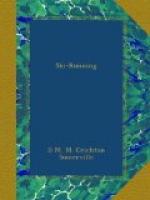The same is apt to happen when people have dried their Skis in the sun by sticking them on end while lunching. The sun not only dries them but warms them so that if the first run after lunch is in shadow and the snow is cold, the Skis stick because the warm surfaces melt the snow, which immediately freezes again and adheres to the Skis, so that they come to an absolute standstill.
The only way to avoid sticking is to keep the running surfaces of the Skis in good condition by oiling them thoroughly and to carry one or two different types of wax for use according to circumstances.
The great thing is to get practice on all types of snow and never to mind it. Look upon crust as a joke, and learn jump turns, which are the only safe turns for any but the strongest runners. Some of these can accomplish a Telemark, or stem-turn or even a Christiania on every sort of snow, but most people are content with the jump turn on crust. The great trouble of this turn is that it is very tiring when a heavy Rucksack is carried, but knack and good use of the stick will help it.
Light is a great factor in Ski-ing. On a fine day when visibility is good, it is easy to distinguish between the rise and fall of country ahead and, therefore, to be prepared for decrease or increase in speed. Some days when the sky is clouded, it is practically impossible to tell what is coming. This difficulty is increased in a narrow valley when the reflection of the slopes on either side make the whole surface look identical.
Coloured glasses may help a little, but it is better to run slowly and to take no risks. On these occasions tracks help immensely as they give the eye something to follow. Rocks and trees also help; anything that breaks the surface of the snow and shows up the gradient ahead.
FALLS
Falls!—what a word. When I first thought of writing this book, it struck me that the best selling title would be “Ski-ing without Falls.” But then I remembered that I could never look a beginner in the face again if, knowing that he had read my book, I saw him fall.
Besides which, a Ski runner who never falls, is probably but a poor exponent of the sport. When you begin to run comfortably and can do the turns at low speeds, falls show that you are still trying to learn more of the game. It is only by trying new things that a runner becomes really proficient and you are almost certain to fall constantly as you learn. There is art in falling on Skis as well as in running and turning. Fall loose. Let yourself go; never try to save yourself when once you find the fall is inevitable and get rid of your sticks. You will have the most amazing falls on Skis and nobody will listen to your descriptions of them because they are just as eager to describe their own. The surprising thing is how little people hurt themselves—knees and ankles go most. The strain on the knee and ankle is very great in some falls, but if you let yourself go and relax your muscles as you fall, you will find that even ankles and knees survive as a rule.




